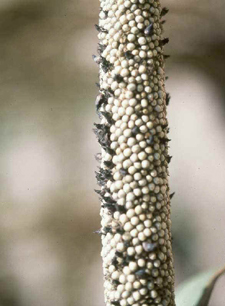Claviceps fusiformis
Claviceps fusiformis is a species of fungus belonging to the genus Claviceps. This genus is well-known for its role in producing the condition known as ergotism in humans and animals who consume grains infected with its members. Claviceps fusiformis is particularly associated with infecting the seeds of pearl millet (Pennisetum glaucum), a crucial cereal crop in arid and semi-arid regions of the world.
Description[edit | edit source]
Claviceps fusiformis produces sclerotia on the seeds of infected plants. These sclerotia are hard, darkened structures that replace the grain of the host plant, and contain the alkaloids responsible for the toxic effects of ergotism. The fungus undergoes a complex life cycle, alternating between asexual and sexual phases to spread and infect host plants.
Habitat and Distribution[edit | edit source]
This fungus is predominantly found in regions where pearl millet is cultivated, including parts of Africa and Asia. The environmental conditions in these areas, such as warm temperatures and moderate to low humidity, are conducive to the development and spread of Claviceps fusiformis.
Impact[edit | edit source]
The presence of Claviceps fusiformis in pearl millet can lead to significant agricultural losses due to the reduction in grain yield and quality. Moreover, the consumption of contaminated grain can cause ergotism in humans and livestock. Ergotism is characterized by symptoms ranging from hallucinations and convulsions to gangrene and can be fatal in severe cases.
Management[edit | edit source]
Management of Claviceps fusiformis involves the use of fungicides, crop rotation, and the cultivation of resistant varieties of pearl millet. Early detection and removal of infected plants are also critical in preventing the spread of the fungus.
Research[edit | edit source]
Ongoing research focuses on understanding the life cycle of Claviceps fusiformis, its interaction with host plants, and the development of more effective management strategies. Genetic studies aim to identify resistance genes in pearl millet that could be used to breed new varieties with enhanced resistance to ergot infection.
Search WikiMD
Ad.Tired of being Overweight? Try W8MD's physician weight loss program.
Semaglutide (Ozempic / Wegovy and Tirzepatide (Mounjaro / Zepbound) available.
Advertise on WikiMD
|
WikiMD's Wellness Encyclopedia |
| Let Food Be Thy Medicine Medicine Thy Food - Hippocrates |
Translate this page: - East Asian
中文,
日本,
한국어,
South Asian
हिन्दी,
தமிழ்,
తెలుగు,
Urdu,
ಕನ್ನಡ,
Southeast Asian
Indonesian,
Vietnamese,
Thai,
မြန်မာဘာသာ,
বাংলা
European
español,
Deutsch,
français,
Greek,
português do Brasil,
polski,
română,
русский,
Nederlands,
norsk,
svenska,
suomi,
Italian
Middle Eastern & African
عربى,
Turkish,
Persian,
Hebrew,
Afrikaans,
isiZulu,
Kiswahili,
Other
Bulgarian,
Hungarian,
Czech,
Swedish,
മലയാളം,
मराठी,
ਪੰਜਾਬੀ,
ગુજરાતી,
Portuguese,
Ukrainian
WikiMD is not a substitute for professional medical advice. See full disclaimer.
Credits:Most images are courtesy of Wikimedia commons, and templates Wikipedia, licensed under CC BY SA or similar.
Contributors: Prab R. Tumpati, MD

